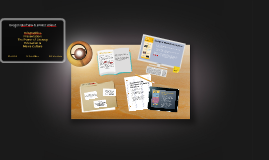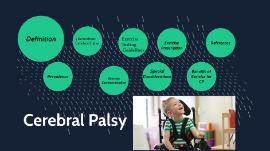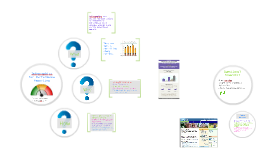Infographics Presentation
Transcript: 5 facts about Cerebral Palsy Exercise Testing Guidelines Cerebral Palsy Definition a non-progressive lesion of the brain occurring before, at, or soon after birth that interferes with normal brain development. Types of CP Spastic CP- has an increases muscle tone in flexor muscle groups of upper limbs and extensors in lower limbs Athetiod CP- involves involuntary movement at the extremities' Dyskinetic Cerebral Palsy- problems controlling the movement of their hands, arms, feet, and legs, making it difficult to sit and walk. Movements are uncontrollable and can be slow or rapid and jerky. Ataxic Cerebral Palsy- problems with balance and coordination. Unsteady when they walk. Have a hard time with quick movements or movements that need a lot of control Mixed Cerebral Palsy- symptoms of more than one type of CP Types of CP Some Effects Include Balance Muscle coordination fine motor skills reflexes involuntary movements delays in motor skills milestones speech development seizes learning ability Effects Classifications CP1- Use electric wheelchairs and are quadriplegic. CP2- Use electric wheelchairs and are quadriplegic. Have better upper body control when compared to CP1. CP3- Use wheelchairs on a daily basis though they may be ambulant with the use of assistive devices. Have issues with head movement and trunk function. CP4- Use wheelchairs on a daily basis though they may be ambulant with the use of assistive devices. Have fewer issues with head movement and trunk function. CP5- Greater functional control of their upper body, and are generally ambulant with the use of an assistive device. Quick movements can upset their balance. CP6- Ambulatory, and able to walk without the use of an assistive device. Their bodies are constantly in motion. CP7- Able to walk, but may appear to have a limp as half their body is effected by cerebral palsy. CP8-Least physically affected by their cerebral palsy, with their disability generally manifested as spasticity in at least one limb. Prevalence 1 in 323 children have Cerebral Palsy More common in males (57%) More common among black children than white children. Prevalence Diagnosed within the first or second year of birth. No correlation with socio-economic status or geography 5 facts Lower level of motor control Limitations are individualized, no two cases the same with severity and muscles effected. Lower levels of physical activity, at greater risk for developing other conditions May need to alter testing to fit the individual Are able to program anaerobic, muscle strengthening, and aerobic exercises No specific contraindications for Cerebral Palsy. Use similar absolute and relative contraindications as you would for general population. Absolute example Unstable angina Relative example Mental or physical impairment leading to inability to exercise adequately Exercise Contraindication An individual with CP should get medical clearance before starting a workout program. Medical clearance Guidelines include trunk, upper body, lower body involvement including functional ROM. Arm and leg ergometry preferred for athetoid CP. Wheelchair ergometry for class 3&4. Treadmill testing for class 5-8, Should involve sub-max steady-state workloads. Athetoid CP should be tested with closed chain movement. Can use cycle ergometry for less severe cases. Should make training based off same principles as general population. If concerns about balance, use leg ergometry, recumbent stationary bike for lower body and hand ergometry for upper. include exercises that increase flexibility Individuals with CP fatigue easily, use multiple short training sessions. Special Considerations Frequency- 3 days per week Intensity- Increase through program progression or increase to the rate of patients performance Time -45-60 min per session. (remember that individuals with CP fatigue faster) Type- flexibility, resistance training, cardiovascular training Exercise Prescription Offset the effects of age a CP Improve strength in weak muscle groups Develop reflexes to improve equilibrium Improve balance limit delay of motor milestones Benefits of Exercise for CP Riebe, D., Ehrman, J. K., Liguori, G., & Magal, M. (2018). ACSMs guidelines for exercise testing and prescription. Philadelphia: Wolters Kluwer. P. 311-319 Maltais, D. B., Wiart, L., Fowler, E., Verschuren, O., & Damiano, D. L. (2014, August). Health-related physical fitness for children with cerebral palsy. Retrieved from https://www.ncbi.nlm.nih.gov/pmc/articles/PMC4227954/ Cerebral palsy. (2019, August 17). Retrieved from https://www.mayoclinic.org/diseases-conditions/cerebral-palsy/symptoms-causes/syc-20353999 What is Cerebral Palsy? (2019, April 30). Retrieved from https://www.cdc.gov/ncbddd/cp/facts.html CPISRA Conference Postponed. (n.d.). Retrieved from https://cpisra.org/ References

















